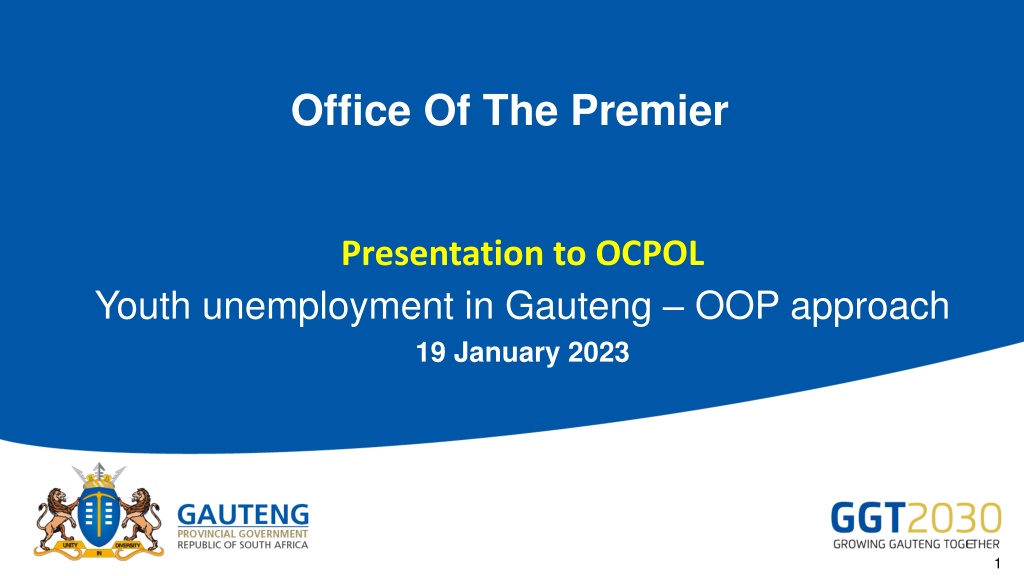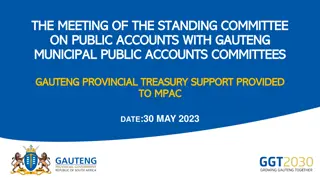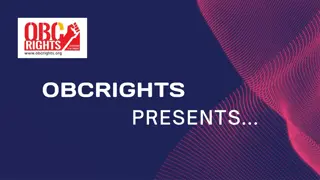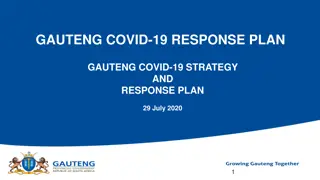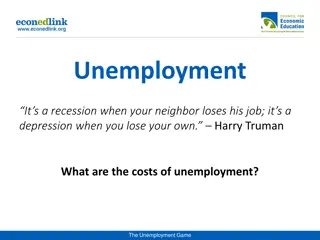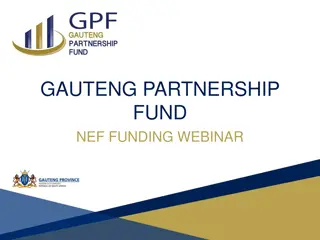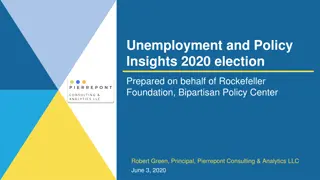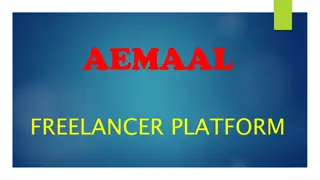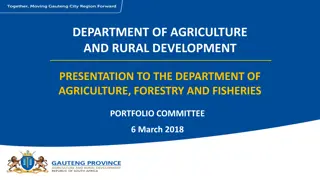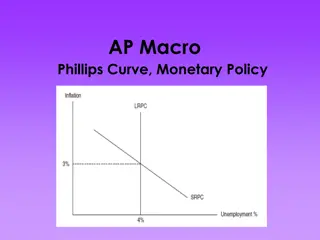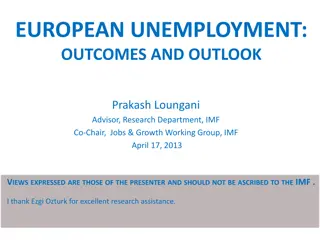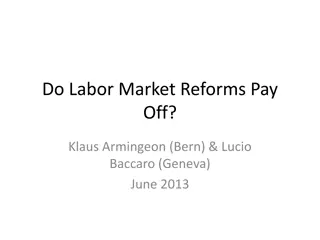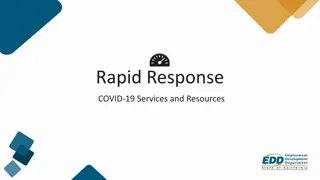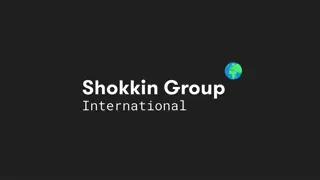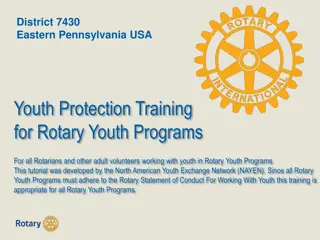Progress on Youth Unemployment Interventions in Gauteng
This presentation outlines the key developments and progress made by the Gauteng Provincial Government in addressing youth unemployment. It covers the purpose, recent developments, overview of the Gauteng Integrated Youth Development Strategy, and the role of the Gauteng Youth Advisory Panel in advancing youth development. The presentation also discusses elevated priorities and targets, including the establishment of a Youth War Room and delivery agreements with MECs.
Download Presentation

Please find below an Image/Link to download the presentation.
The content on the website is provided AS IS for your information and personal use only. It may not be sold, licensed, or shared on other websites without obtaining consent from the author. Download presentation by click this link. If you encounter any issues during the download, it is possible that the publisher has removed the file from their server.
E N D
Presentation Transcript
Office Of The Premier Presentation to OCPOL Youth unemployment in Gauteng OOP approach 19 January 2023 1
PRESENTATION OUTLINE 1. Purpose 2. Key developments since the previous OCPOL Workshop 3. Overview of GIYDS 4. Role of Gauteng Youth Advisory Panel s in advancing youth Contents development 5. Progress to date: Youth employment and entrepreneurship 6. Elevated GGT priorities and delivery structure 7. Youth employment-related elevated GGT priorities and targets in delivery Agreements between premier & MECs 8. Youth War Room / Youth Workstream 2 9. Conclusion
PURPOSE The purpose of this presentation is to respond to the OCPOL workshop outcomes on youth unemployment interventions by the Gauteng Provincial Government Please note the requested information 3
KEY DEVELOPMENTS SINCE THE LAST OCPOL WORKSHOP Event Date First Draft Gauteng Integrated Youth Development (GYIDS) circulated to stakeholders for input March 2022 to June 2022 Gauteng Youth Advisory Panel (GYAP) appointed by former Premier David Makhura 16 June 2022 GYAP contributes to finalisation of strategy and consultations with youth formations July to November 2022 Communication team conducts survey for rebranding Tshepo Programme and develops a communication plan for the GYIDS March 2022 to November 2022 New Premier Lesufi consults with departments on elevated GGT priorities and additional commitments for implementation over 100-day, 6 months, 12 months and end of term periods to be included in Delivery Agreements with MECs October to December 2022 EXCO Lekgotla resolves that a Project Management Office should be set up in the OoP to monitor implementation of delivery agreements War Rooms are replaced with workstreams and Youth War room is annexed within the economic recovery workstream EXCO Lekgotla adopts the final GYIDS and communication strategy and recommends deployment of GYAP members to individual departments 31 October 2022 7 December 2022 Premier signs delivery agreements with MECs incorporating legislated transversal youth targets and specific youth development interventions by each department 12 December 2022 4
OVERVIEW OF THE GAUTENG INTERGRATED YOUTH DEVELOPMENT STRATEGY
OCPOL WORKSHOP ON YOUTH UNEMPLOYMENT SITUATIONAL ANALYSIS 6
GAUTENG YOUTH DEMOGRAPHICS 1000000 Gauteng Youth Demographics, 2021 900000 800000 700000 600000 500000 874911 854935 841564 827240 400000 677086 672225 300000 542072 534347 200000 100000 0 15-19 20-24 25-29 30-34 Males Females Age category Males 534 347 677 086 827 240 874 911 2 913 584 Females 542 072 672 225 841 564 854 935 2 910 796 TOTAL 1 076 419 1 349 311 1 668 804 1 729 846 5 824 380 15-19 20-24 25-29 30-34 709 437 are in Public and Independent Schools 32 613 LSEN Schools GDE, 2022 GDE, 2022
HOW DO GAUTENG YOUTH FEEL ABOUT THEMSELVES? hat does eing a young erson in outh Africa today ean What does being a young person in South Africa today mean? 9.1 Status of Youth Report 2018 Words youth associated with being a young person in Gauteng were largely negative and pessimistic: i.e Drugs, Hopeless, generation, Entitled, Corruption, Bad Role Models, Ill-informed, Unfocussed, Lazy, Crime, Escape reality and Talented Misguided Disrespectful, . Same sentiments expressed by Gauteng youth participants during focus group discussions conducted for the purposes of rebranding Tshepo 1 million diagram) Source: Gauteng Office of the Premier, 2022 8 (see right
BUT THERE IS HOPE: 9 Source: Communication Unit, Gauteng OoP, 2022
SITUATIONAL ANALYSIS 9.2. Status of youth is desperate, but we have done well in terms of: Reducing poverty & inequality (until Covid-19 struck) Universal access to basic education Supporting in-school youth Creating youth development policies, programmes & institutions Funding youth development programmes to address situation of youth Not in Education, Employment, or Training (NEET) Reducing HIV/AIDS-related mortality rates and increasing access to treatment 10
SITUATIONAL ANALYSIS Cont. 9.3. Status of youth is desperate. We have to do better i.r.t.: Quality of basic education and outcomes Wider Access to quality Post School Education and Training (PSET) High learner drop-out/failure/repetition rates throughout our education system Unconducive learning environment in-and out of learning institutions Creating employment and jobs for youth Supporting young entrepreneurs and the self-employed Promoting mental health and well-being Depression among the youth is sky-high and it triggers suicide, substance abuse and criminal behaviour 11
SITUATIONAL ANALYSIS Cont. 9.4. Status of youth is desperate. We have to do better i.r.t.: Teenage pregnancies GBVF, crime, violence corruption, apathy, social and moral fibre decline, declining civic Youth in conflict with the law insufficient data on the scale of the problem Youth HIV ignorance/denialism (i.t.o. contracting the disease) Social cohesion, nation-building Coordinating efforts across government and with private sector Monitoring & evaluation of impact and collection of Baseline data & Knowledge management 12 Communication raising awareness on available programmes
GIYDS OBJECTIVES Integrate youth development into the mainstream of policies, programmes, strategies and the provincial budget Deliver positive youth development outcomes in addressing the needs of young people and building their assets Support young people, particularly those outside the social, political and economic mainstream Ensure responsiveness by linking young people with relevant service providers Promote and advocate for young eo le s access to quality services as a means to facilitate their smooth transition into independence Support a culture of patriotic citizenship among young people to help them become responsible adults who care for their families and communities Strengthen the capacity of key youth development institutions in delivery of coordinated package of services for the youth; and Facilitate young eo le s engagement in building a better Gauteng City Region, South Africa, Africa, and a better world lease note the requested information form OCPOL 13
GAUTENG INTERGRATED YOUTH STRATEGY FIVE STRATEGIC PILLARS & PROPOSED INTERVENTIONS 14
Strategic Pillars of the Approved GIYDS Strategic pillar Two: Economic transformation, entrepreneurship, and job creation Strategic Pillar Three: Physical and mental health promotion including covid-19 Strategic Pillar Five: Effective and responsive youth development machinery Strategic pillar: One: Quality education, skills and second chances Strategic Pillar Four: Social cohesion and nation- building 15
Strategic goal Youth are empowered with adequate and relevant qualifications and skills for personal growth pathways and prosperity of the GCR INTERVENTIONS Implement Tshepo programme to support NEETs with: a.Job preparedness training b.Entrepreneurship training Increase access to bursaries for PSET Roll out Leaner Driver Courses for eligible Grade 11-12 learners and PSET students Support young people in TVET colleges, including their theoretical and work integrated learning Increase partnership spend on PSET Roll out Schools of Specialisation Roll out full-service schools Extend provision of ICT resources to schools Roll out mass Digital Learning Platforms (DLPs) Broaden broadcasting of Maths and Science to schools Establish career/advisory centres across GCR districts Increase access to psychosocial support services to youth for at-risk youth (e.g., Grade 9s, pregnant teenagers, substance abusers, LGBTQIA+ etc.) Implement programmes for out-of-school youth with various options e.g.: a.Self-directed learning b.Online facilitated learning c.Tutor supported leaning Roll out learner retention and second chance programmes partnership programmes (i.e., for learners or students who drop-out fail or repeat) Roll-out safe scholar transport to eligible schools Monitor scholar transport driver and vehicle roadworthiness Provide subsidized public transport for eligible PSET students and NEETs (e.g., discounted coupons for buses & Gautrain) OBJECTIVES To improve youth access to quality education (formal and non-formal) and skills opportunities To ensure adequate resourcing for HDIs and at-risk learners (e.g., girls/women, disabled, township, dropouts) throughout all phases of the education system To create an enabling learning environment within educational institutions and around them To foster public, private and civil partnerships among public for delivery of learning and capacity building opportunities development PILLAR 1: QUALITY EDUCATION, SKILLS TRAINING & SECOND CHANCES communities 16
Strategic Goal: Youth are actively engaged in transformative, income-generating and value-adding economic activities OBJECTIVES INTERVENTIONS To promote youth participation in key economic sectors through strategic job creation, placements, entrepreneurship, and skills development programmes To ensure transformative and equitable youth participation within the economy To level the playing field by creating enabling business environment (deal with issues that prevent (e.g., procurement, red tape) To leverage youth s access to business finance and other support in the public and private sectors through effective partnerships PILLAR 2 ECONOMIC TRANSFORMATION, ENTREPRENURSHIP & JOB CREATION Job creation programmes Implement Tshepo programme focusing on: a.Job placements b.Job preparedness training c.Sector-specifics skills training d.Internships Enhance youth employment through sector specific economic Action Labs Entrepreneurship development programmes Implement Tshepo programme Increasing procurement spend by GCR entities Sector-specific skills development programmes Support youth-owned business in the 10 high-growth sectors in terms of: -Business finance -Business development services -Mentorship Support youth-owned businesses through incubation programmes Support youth-owned cooperatives with full-suite business development services Support youth-owned businesses in Township, Informal Settlements and Hostels (TISH) and Township Enterprise Zones 17
Strategic Goal: Youth feel safe and lead healthy, productive, and fulfilled lives Objectives To ensure that youth are brought up and live in environments conducive to making healthy choices To broaden youth s access to quality physical and mental health services To mitigate against the impact of health pandemics such as Covid -19 To improve the safety of young people and their access to youth- friendly services (especially vulnerable groups such as women and LGBTQIA+) Interventions Physical & mental health programmes implemented with partners in the private and civil sector Roll out access to medical prevention and treatment equipment and aids, particularly: a.Health kiosks /mobile health units b.Voluntary/Self-testing kits c.Vaccination d.Circumcision e.Reproductive health/ Prevention (e.g., condoms, contraceptives) f. Dignity and other packs (e.g., sanitary pads, toiletries, masks etc.) g.ARVs h.TB, Cancer and other chronic medication i. Free check-ups at learning institutions Roll out awareness and prevention programmes focusing on: a.Mental health and illness b.Family planning c.Substance abuse d.GBVF e.Sexuality / Safe sex f. HIV/AIDs g.Cancer and other chronic diseases h.The role of sport/arts/culture/recreation in physical and mental fitness PILLAR 3: PHYSICAL AND MENTAL HEALTH & WELL BEING PROMOTION 18
Strategic Goal: Youth feel safe and lead healthy, productive, and fulfilled lives INTERVENTIONS Roll out medical and psychosocial support services such as counselling in educational, sport and other multipurpose facilities (including by alternative and traditional service providers) Extend after-hour services at public medical and related facilities (e.g., for pregnancy termination, GBVF victims, gynaecological consultations, etc.) Roll out GBVF Victim Empowerment Centres (VECs) in educational, sport and other multipurpose facilities Roll out early warning victim support services for GBVF victims (e.g., toll-free numbers, panic buttons, digital reporting platforms, pepper sprays Roll out self-defence training programmes Build a cadre of healthcare professionals and paraprofessionals by: a. Training health awareness ambassadors b.Training peer-counsellors c.Providing flexible vocational and internship courses for graduates and postgraduates in Psychology, Social Work, Medicine and related fields Establish regional rehabilitation centres in all 5 GCR regions in partnership with stakeholders Introduce a pathway for mobility (skills development or job placement) for youth in rehabilitation centres Implement safety net programmes for homeless and orphaned youth with other partners including: a.Homeless shelters b.Improve access to social grants, medical and other services c. Extend food parcels and other necessities to eligible youth Targeted interventions for youth with disabilities and albinism including: a.Walking and other mobile aids (e.g., wheelchairs) b.Braille and other audio-visual reading aides PILLAR 3: PHYSICAL AND MENTAL HEALTH & WELL BEING PROMOTION CONT 19
Strategic Goal: Youth are meaningfully included in the affairs of the province and efforts to create more cohesive communities OBJECTIVES INTERVENTIONS To promote patriotism and nation building among young people through civic awareness and building their capacity and social capital/social networks To mainstream the support of LGBTQIA+, youth living with disabilities and people living with albinism in implementation of youth development programmes To provide targeted preventive, rehabilitative and second- chance interventions for young offenders that also reduce recidivism and foster reintegration To promote youth engagement in sports and cultural activities Increase youth participation in June 16 and other national commemoration days Implement programmes to increase and strengthen youth clubs Implement an Annual South African Youth Cultural Festival Implement education and awareness programs on various youth development issues and programmes in partnership with different stakeholders including on: a. Building an inclusive society b. Racism GBVF, hate crimes, xenophobia, homophobia, transphobia and the importance of reducing any forms of discrimination and stigmatization Implement exchange programmes Provide targeted support for vulnerable groups (e.g. LGBTQIA+, persons with disabilities and albinism) Create safe spaces in the Gauteng City Regions PILLAR 4: SOCIAL COHESIO N AND NATION BUILDING 20
Strategic Goal: Youth are meaningfully included in the affairs of the province and efforts to create more cohesive communities INTERVENTIONS CONT Enlist more youth in the National Youth Service and other government programmes Promote and enable social entrepreneurship and economic opportunities in the creative and social sectors PILLAR 4: SOCIAL COHESION AND NATION BUILDING CONT Develop cadres of youth to serve in the security cluster (e.g., Community patrollers, youth brigades, scholar patrollers) Implement adopt a cop in all public schools Implement partnership safety programmes within institutions of learning Implement diversion programmes for youth in conflict with the law in partnership with other stakeholders 21
Strategic Goal: Youth development interventions are youth led, well resourced, mainstreamed and coordinated across the GCR OBJECTIVES INTERVENTIONS To ensure that youth development is mainstreamed in all policies, programmes and plans of government and other role-players involved in delivering services to youth To ensure that youth policies are inclusive To enhance the knowledge creation and dissemination capacity of the youth sector To initiate, capacitate and support various platforms that amplify youth voices and strengthen youth formations partnership with private and civic sectors Youth Excellence Awards Implement the Communication Plan focusing on: a)Awareness campaigns on various youth topics b)Coordinating youth engagement events c)Creating media platforms (incl. social media) PILLAR 5: EFFECTIVE & RESPONSIVE YOUTH MACHINERY Establish functional and well-resourced Youth Units in offices of all provincial and municipal Heads of Departments including Executive Mayors offices) Establish a Youth Research Centre in partnership with GCRO and institutions of higher learning Conduct Research pertinent /topical issues including: a)Youth in conflict with the law b)Substance abuse c)LGBTQIA+ issues d)Entrepreneurship e)State of Youth Survey Conduct mid-term and end of term evaluation of the GIYDS Implement Research, Monitoring and Evaluation capacity building programme (incl. digital) Create a database for monitoring youth NEETs Revision of existing policies and lobby for new policies around LGBTQIA+ communities Roll out youth leadership development programmes in 22
INSTITUTIONAL ARRANGEMENTS & RESOURCING Institutional arrangements o The Youth Directorate in the OOP is the custodian of the GIYDS o It will work closely with the MEC responsible for Youth Development to coordinate the implementation of the GIYDS 2030 with the support of the Gauteng Youth Advisory Panel Resources for youth development (Gauteng budget speech 2022 highlights) o GPG allocated R2,4 billion for youth development - R376 million to be spent on the Youth Brigade over the 2022 MTEF period o R13.1 million allocated for Department of Community Safety to hire more patrollers to fight crime in the province o R2 billion allocated by National Treasury for the Presidential Youth Employment Initiative 23
INSTITUTIONAL ARRANGEMENTS & RESOURCING Cont. The fight towards eradicating high levels of youth Youth Initiatives Cluster Summary FY 2022-23 unemployment/ economic inactivity has been Clusters Target Budget prioritised by all 13 Departments within the Province Economic Cluster 598 132 R628 042 086 Collectively, all GPG departments have prioritised Social Cluster 172 893 R2 237 231 256 over R3.233 billion in the current financial year, expecting to create approximately 1.032 million Governance Cluster 261 288 R368 400 315 wide-ranging opportunities towards the youth in Total 1 032 313 R3 233 673 657 Gauteng 24
GAUTENG INTERGRATED YOUTH STRATEGY COMMUNICATIONS
GIYDS COMMUNICATION It is proposed that all departments communicate both the social and economic value of engagements and achievements on youth development in line with the Gauteng Youth 2030 Communication Strategy which is envisaged to augment the current communications plan 26
COMMUNICATIONS OBJECTIVES 1. To drive meaningfully engagement with young people and stakeholders 2. To inform young people of opportunities to improve their lives 3. To promote health services to young people with emphasis on mental health 4. Create awareness, advocacy and educate the youth about interventions, programmes and policies aimed at achieving an inclusive society 5. To celebrate young achievers in Gauteng to motivate and inspire others 6. To communicate the milestones and achievements of government, its stakeholders and partners 27
MONITORING & EVALUATION The absence of Monitoring and Evaluation (M&E) plans has been identified as one of the biggest weaknesses of the previous Gauteng youth development strategies An M&E plan is important for gauging the effectiveness of youth development programmes and improving on coordination, avoiding duplication and massifying interventions for sustainable impact Without a credible M&E plan there is no assurance that verifiable performance data is collected on the achievement of targets in line with the rogra e s objectives To close this gap, this part of the strategy clarifies indicator targets per strategic pillar, key interventions, timeframes, and responsible entities. Time frame can either categorised as short term (1-3 years), medium term-4-8 years, or long term (8 years or more). 28
ROLE OF THE GAUTENG YOUTH ADVISORY PANEL IN ADVANCING YOUTH DEVELOPMENT
ABOUT THE GAUTENG YOUTH ADVISORY PANEL (GYAP) The Gauteng Youth Advisory Panel ( GYAP ) appointed by former Premier David Makhura on 16 June 2022 Its current term is from June 2022 to March 2024 GYAP comprises 14 youth representing a wide range of youth formations from across the GCR (15TH member to be appointed in new financial year) The primary role of the GYAP is to advice the Premier & EXCO provide oversight and advocacy on youth development and make recommendations on relevant youth matters, mainstreaming of youth development & delivery of services by GPG to young people Other key GYAP activities are: Finalising the GIYDS 2030 in consultation with the youth sector Monitoring the effectiveness of delivery structures tackling youth issues Liaising with stakeholders across all sectors of society Conducting relevant research on youth topics 30
GAUTENG YOUTH ADVISORY PANEL MEMBER DEPLOYMENT NAME DEPARTMENT Oagile Louw Office of the Premier and AIDS Council Zulaikha Patel Community Safety and Security Vuyolethu Sibiya Transport and Logistics Irfaan Mangera Education Dimpho Lekgeu Infrastructure Development Jos Andre Finance Paballo Ponoane Health and Wellness Lorraine Dimakatso Mahlosane Human Settlements Vuyiswa Jentile Traditional Affairs Ndumiso Hadebe Economic Development Emma Lavinia George Cooperative Governance Duduzile Nyumbeka eGovernance and Research Luthando Mafunda Social Development Onkgopotse Peete Sport, Arts, Culture and Recreation 31
PROGRESS TO DATE: YOUTH EMPLOYMENT AND ENTREPRENURSHIP PROGRAMMES AND OUTCOMES
PROGRESS ON YOUTH EMPLOYMENT AS AT THE END OF Q2-2022/23 Youth Employment Progress Skills Development Progress o 38 opportunities/ programmes (DSD) o 10 226 beneficiaries participated in the Welfare to work Programme. o 573 work opportunities created through Tshepo 1 million 561 youth accessing Income economic generating o 310 unemployed youths trained in the automotive skills in collaboration with Tshepo one million (GGDA) o 98 youth trained in ICT skills (GGDA) o 38 606 youth are participating in skills development programmes (DSD) Planned Performance for 2022/23 o 1000 of bursary allocations to youth (GDE). o 40 000 of youth benefiting from workplace experience programmes (including PYEI). (GDE) o 3000 of youth in structured skills development programme (apprenticeship/learnership/skills programmes/work integrated learning) 33
GAUTENG YOUTH (15-34YRS) LABOUR MARKET NUGGETS The number of employed youth in Gauteng grew by 34 Gauteng Q1:2022 Q2:20222 Q3:2022 Q/Q Change YTD Change 000 from Q2:2022 to a level of 1 525 000 in Q3:2022 Thousands Labour force The number of employed youths in South Africa grew 2 878 2 888 2 916 28 121 by 25 000 from Q2:2022 to a level of 5 505 000 in Employed 1 425 1 491 1 525 34 92 Q3:2022 Unemployed 1 454 1 397 1 390 -6 29 Unemployment rate (%) The Unemployment rate for Youth in South Africa 50,50% 48,36% 47,68% -0,68 pp -1,0 pp decreased by 1.1 percentage points from 46,55% to Percentage points = pp 45.47% The Unemployment rate for Youth in Gauteng South Africa Q1:2022 Q2:20222 Q3:2022 Q/Q YTD decreased by 0.68 percentage points from 48.36% Thousands to 47.68% Labour force 9 791 10 253 10 096 -157 544 The Youth labour force in Gauteng increased by 28 Employed 5 111 5 481 5 505 25 639 000 from 2 888 000 in Q2:2022 to 2 916 000 in Unemployed 4 680 4 772 4 590 -182 -95 Q3:2022 Unemployment rate (%) 47,80% 46,55% 45,47 -1,1 pp -3,6 pp The Youth labour force increased by 121 000 for the year to date
246909,1 246909,1 246909,1 GAUTENG YOUTH BUSINESS OWNERSHIP Gauteng youth business ownership - (Q2 & Q3:2022) Nearly 224 441 young people owned businesses in Gauteng, in the third quarter of 2022 (Q3:2022). 189497.1 186715.5 200000 180000 160000 Compared to Q2:2022, Gauteng had 2431 less youth owning businesses in Q3:2022. 140000 120000 100000 80000 60000 As would be expected, more than 80% of young people who owned businesses in Gauteng in the two quarters (Q2 and Q3:2022) were of cohort 25-35. 37725.7 37375.4 40000 20000 0 Q2 business ownership Q3 business ownership 15-24 25-34 Data source: Stats SA Johannesburg had the most of young business owners across the two quarters; followed by Ekurhuleni, Tshwane and non-Metro areas in that order. Youth businesss ownership by corridor Non Metro Ekurhuleni City of Johannesburg City of Tshwane 24501,9 64531,1 26901,8 60817,5 85592,8 88733,9 52246,7 47988
Decent employment through inclusive Growth as at the end Quarter Two 2022/23 Dept. Performance Indicator DED # (1582) jobs created through Township Economy Programmes The total of 11 597jobs as at Q2- 2022/23 SACR # (1657) job opportunities created through arts and culture programmes # (2 138) job opportunities created through heritage programme GDARD # (1 675) work opportunities created through Tshepo 1 million DHS # ( 35) jobs created through the Human Settlements Development Grant per financial year (Skilled Labour) GGDA # (29) Jobs created in the automotive value chain # (69) indirect jobs facilitated through strategic partnerships # (2 052) jobs created through investments facilitated GTA # (509) people employed through Working for Tourism Programme over the MTEF # (400) temporary jobs created through working for tourism projects COHWHS # (62) job opportunities created through a roads and cycling maintenance programme TASEZ # (889) permanent jobs created by tenants in the zone. # (500) temporary jobs created in the zone 36
Performance Report on Jobs Created: Quarter Two 2022/23 Department Performance Indicator A total of 74 624 EPWP as at Q2 EPWP Opportunities DID # (17 283) of EPWP work opportunities reported by Municipalities in Gauteng # (1 558) of EPWP work opportunities reported by the environment sector in Gauteng (Departments) # (6 172) of EPWP work opportunities reported by the infrastructure sector in Gauteng (Departments) # (31 590) of EPWP work opportunities reported by the social sector in Gauteng (Departments) DHS # (867) of work opportunities created through the Human Settlements Development Grant and the Expanded Public Works Programme Incentive Grant each financial year (Unskilled Labour) # (6812) of EPWP work opportunities created DSD # (10 226) of beneficiaries participating in the Welfare- to -Work Programme GGDA # (126 ) of job opportunities created through EPWP (Infrastructure Sector) DCS # (6 000) crime wardens currently being recruited in 5 corridors. 37
SHORTLISTING OF 6 000 YOUTH PEACE WARDENS AS AT 21/12/22 Corridor Wards Number of TISH Wards Townships & 26 Priority townships programme Informal Settlements Hostels Capacity 106 14 (9) 128 05 64 1072 Northern Corridor 136 18 (3) 66 22 81 1340 Central Corridor 112 78 (5) 145 21 89 1468 Eastern Corridor 73 08 (5) 53 04 53 892 Southern Corridor 102 06 (4) 74 18 74 1228 Western Corridor Total 529 124 (26) 466 70 361 6000 38
ELEVATED GGT PRIORITIES & DELIVERY STRUCTURE
ELEVATED PRIORITIES UNDERPINNED BY A FOCUS ON TISH AREAS Accelerated economic recovery 1. Strengthen the battle against crime, corruption, vandalism, and lawlessness Strengthen the capacity of the state to deliver services 2. Strengthen the battle against crime, corruption, vandalism, and lawlessness Improve Health and wellness of communities Improve living conditions in townships, informal settlements, and hostels (TISH) 3. Improve living conditions in townships, informal settlements, and hostels TISH Improve health and wellness of communities 4. Accelerated Economic recovery Focus on Incomplete Infrastructure Strengthen the capacity of the state to deliver services 5. Focus on incomplete Infrastructure investment 6. 40
DELIVERY AGREEMENT STRUCTURE Delivery Priorities These are key priorities that the MEC must closely monitor and ensure implementation thereof. These priorities have also been identified as being strategic in that they are meaningful, measurable and movable, and will show significant impact on service delivery in the current political term. The PMO will work with departments to monitor progress, verify data and support implementation of the outcomes. Progress against the targets will be reported at routine stocktakes with the Premier s Stocktake meetings Premier s Elevated Priorities must be included in the APP and funded in the department s budgets 100-day target 6-month Target 12-month Target Cumulative end of term target (March 2024) Intervention Indicator Q3 2022/3 (15 January 2023) Q4 of 2022/3 (March 2023) Q2 of 2023/4 (Oct 2023) 41 Delivery agreement indicators and target matrix
TRANSVERSAL TARGETS Cross Cutting Responsibilities In addition to the above departmental specific targets, all MECs further commit to contribute to achieving the following cross cutting targets. These targets will be monitored by the relevant transversal (CoG) departments and reported quarterly to the Office of the Premier s Performance Monitoring and Evaluations unit; and the Provincial Legislature Category Indicator Annual Target Percentage spend on women-owned businesses 40% Preferential Procurement Percentage spend on PWD-owned businesses 7% Percentage spend on Township businesses 30% Percentage spend on Youth businesses 30% Lifestyle Audits on SCM Officials Payment of Suppliers 100% 15 or 30 days Financial Management 42
YOUTH EMPLOYMENT-RELATED ELEVATED GGT PRIORITIES AND TARGETS IN DELIVERY AGREEMENTS BETWEEN PREMIER & MECs
DEPARTMENT OF COMMUNITY SAFETY Indicator Cumulative end of term target (March 2024 100-day target (End of Q3 2022/23) 6-month Target (End of Q2 2022/23) 12-month Target (End of Q2 2023/24) Number of school safety programmes implemented (including road safety) for learners in partnership with other government departments (Education, DSD, SACR, SAPS) 115 school safety programmes implemented (including road safety) 230 school safety programmes implemented (including road safety) 460 school safety programmes implemented (including road safety) school safety programmes implemented (including road safety) Number of crime prevention wardens recruited Advertisement published on the 15/11/2022. Training of 6 000 crime prevention wardens conducted by the MPD s training centres Hammanskraal 02/1/2023 31/03/2023 Declaration of peace officers will be conducted. 28/2/2023. Appointment of 6 000 crime prevention wardens permanently. 3/4/2023 19/4/2023 Procurement of tools of trade for the crime prevention wardens 6 000 crime prevention wardens recruited & SAPS between 15/2/2023 Percentage preferential procurement spend on enterprises that are Youth-owned 30% 30% 30% 30% 44
DEPARTMENT OF E-GOVERNMENT Indicator Cumulative end of term target (March 2024 100-day target (End of Q3 2022/23) 6-month Target (End of Q2 2022/23) 12-month Target (End of Q2 2023/24) Number of previously disadvantaged ICT entrepreneurs supported 100 120 185 250 Number of people benefiting from ICT skills development programme (Action Lab Programme) 6000 8000 13000 15000 Percentage preferential procurement spend on enterprises that are Youth- owned 30% 30% 30% 30% 45
DEPARTMENT OF AGRICULTURE & RURAL DEVELOPMENT Indicator Cumulative end of term target (March 2024 100-day target (End of Q3 2022/23) 6-month Target (End of Q2 2022/23) 12-month Target (End of Q2 2023/24) No. of EPWP participants working on Bontle ke Botho 2 980 6000 8 000 16 980 No. of youth trained in food production programmes as part of the rehabilitation programme 100 1 000 2000 3100 Percentage preferential procurement spend on enterprises that are Youth- owned 30% 30% 30% 30% 46
DEPARTMENT OF ECONOMIC DEVELOPMENT Indicator Cumulative end of term target (March 2024 100-day target (End of Q3 2022/23) 6-month Target (End of Q2 2022/23) 12-month Target (End of Q2 2023/24) Number of refurbished stores under the Kasi Umnotho (KU) programme 2555 stores under the Kasi Umnotho (KU) programme 10 000 stores under the Kasi Umnotho (KU) programme 20 000 stores under the Kasi Umnotho (KU) programme 30000 stores under the Kasi Umnotho (KU) programme Percentage preferential procurement spend on enterprises that are Youth- owned 30% 30% 30% 30% 47
DEPARTMENT OF EDUCATION Indicator Cumulative end of term target (March 2024 100-day target (End of Q3 2022/23) 6-month Target (End of Q2 2022/23) 12-month Target (End of Q2 2023/24) Number of learners enrolled in welfare and wellness programme Programme developed Number of learners reported by DSD entering rehabilitation and integration/after care programmes. Number of learners reported by DSD entering rehabilitation and integration/after care programmes. Youth Development The Repositioning of Gauteng City Region Academy (GCRA) Targets to be ascertained when the function is handed over to Education from Office of the Premier Percentage preferential procurement spend on enterprises that are Youth- owned 30% 30% 30% 30% Percentage of grade 12 learners who passed the NCS examination 85% 86% 86% 86% Percentage of grade 12 learners with a bachelor pass 44% 45% 45% 45% Percentage of youth in conflict with the law supported Programme developed 100% of placed youth 100% of placed youth 100% of placed youth 48
DEPARTMENT OF HUMAN SETTLEMENTS Indicator Cumulative end of term target (March 2024 100-day target (End of Q3 2022/23) 6-month Target (End of Q2 2022/23) 12-month Target (End of Q2 2023/24) Number of serviced stands handed over to beneficiaries Release land to young people for access to building and occupying better housing (priority 39) 60% allocation to youth based on total sites ready for release 600: 60% of 1000 RLRP sites to be allocated to the youth 860 RLRP acquired from the private sector 1350: 60% of 2250 RLRP sites to be allocated to the youth 60% of the total RLRP serviced sites to be allocated to the youth RLRP (subject to the BP approval and related budget by the NDHS) 2824 RLRP acquired from the private sector 60% of (100% planned: 2000) RLRP sites to be allocated to the youth with additional sites to be confirmed once market testing has been concluded (GPF procurement process to determine additional RLRP opportunities) 60% of total the serviced sites to be allocated to the youth Total planned RLRP sites acquired from prior years and under planning remaining as planning work in progress Obed Mthombeni: 764 by August 2023 GPF to release 2500 sites for RLRP 75 000 RLRP serviced sites Number of jobs & work opportunities created through EPWP work Opportunities & the HSDG & EPWP Incentive grant 85 work opportunities 11000 jobs & work Opportunities created 7500 work opportunities 3500 jobs 11000 jobs & work Opportunities created 7500 (Work opportunities) 11 000 (Jobs) 34202 jobs & work Opportunities created 28184 work opportunities (unskilled) 6018jobs (skilled) Percentage preferential procurement spend on enterprises that are Youth-owned 30% 30% 30% 30% 49
DEPARTMENT OF INFRASTRUCTURE DEVELOPMENT Indicator Cumulative end of term target (March 2024 100-day target (End of Q3 2022/23) 6-month Target (End of Q2 2022/23) 12-month Target (End of Q2 2023/24) Number of Direct jobs created in the construction sector by Public Provincial Projects 700 1 050 Number of indirect jobs created in the construction sector by Public Provincial Projects 3 747 9 352 Number of Expanded Public Works Programme work opportunities created through GPG Departments 17 156 45 292 Number of Expanded Public Works Programme work opportunities created through GPG Municipalities 38 584 Percentage preferential procurement spend on enterprises that are Youth- owned 30% 30% 30% 30% 50
